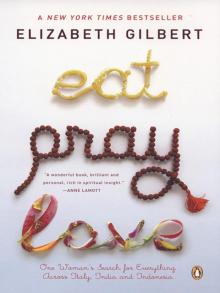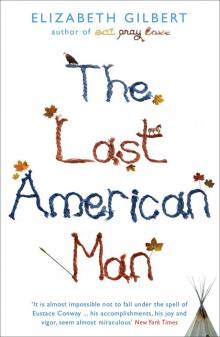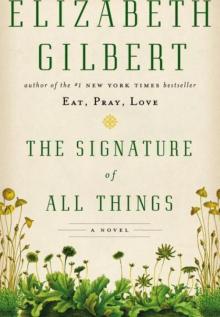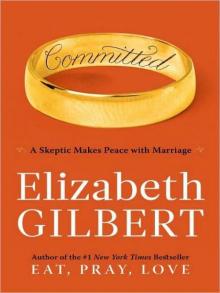- Home
- Elizabeth Gilbert
Committed Page 13
Committed Read online
Page 13
So it will come to pass for all of us—for all couples who stay with each other in love—that someday (if we are lucky enough to have earned a lifetime together) one of us will carry the shovel and the lantern on behalf of the other. We all share our houses with Time, who ticks alongside us as we work at our daily lives, reminding us of our ultimate destination. It’s just that for some of us Time ticks particularly insistently . . .
Why am I talking about all this right now?
Because I love him. Have I actually gotten this far in my book without having yet said that clearly? I love this man. I love him for countless ridiculous reasons. I love his square, sturdy, Hobbit-like feet. I love the way he always sings “La Vie en Rose” when he’s cooking dinner. (Needless to say, I love that he cooks dinner.) I love how he speaks almost perfect English but still, even after all these years with the language, sometimes manages to invent marvelous words. (“Smoothfully” is a personal favorite of mine, though I’m also fond of “lulu-bell,” which is Felipe’s own lovely translation for the word “lullaby.”) I love that he has never quite mastered the exact wording or pacing of certain English-language idioms either. (“Don’t count your eggs while they’re still up inside the chicken’s ass,” is a terrific example, though I’m also a big fan of “Nobody sings till the fat lady sings.”) I love that Felipe can never—not for the life of him—keep straight the names of American celebrities. (“George Cruise” and “Tom Pitt” are two prime examples.)
I love him and therefore I want to protect him—even from me, if that makes sense. I didn’t want to skip any steps of preparation for marriage, or leave anything unresolved that might reemerge later to harm us—to harm him. Worried that, even with all this talking and researching and legal wrangling, I might be missing some important relevant matrimonial issue, I somehow got my hands on a recent Rutgers University report called “Alone Together: How Marriage Is Changing in America,” and went a little crazy with it. This massive tome carefully sorts through the results of a twenty-year survey on matrimony in America—the most extensive such study ever produced—and I pored over the thing like it was the veritable I Ching. I sought solace in its statistics, fretting over charts about “marital resilience,” searching for the faces of Felipe and me hidden within columns of comparable variance scales.
From what I could understand of the Rutgers report (and I’m sure I didn’t understand everything), it seemed that the researchers had discovered trends in “divorce proneness,” based on a certain number of hard demographic factors. Some couples are simply more likely to fail than others, to a degree that can be somewhat predicted. Some of these factors sounded familiar to me. We all know that people whose parents were divorced are more likely to someday divorce themselves—as though divorce breeds divorce—and examples of this are spread across generations.
But other ideas were less familiar, and even reassuring. I’d always heard, for instance, that people who had divorced once were statistically more likely to also fail in their second marriage, but no—not necessarily. Encouragingly, the Rutgers survey demonstrates that many second marriages do last a lifetime. (As with seagull love affairs, some people make bad choices the first time, but do far better with a subsequent partner.) The problem comes when people carry unresolved destructive behaviors with them from one marriage to the next—such as alcoholism, compulsive gambling, mental illness, violence, or philandering. With baggage like that, it really doesn’t matter whom you marry, because you’re going to wreck that relationship eventually and inevitably, based on your own pathologies.
Then there is the business of that infamous 50 percent divorce rate in America. We all know that classic statistic, don’t we? It gets tossed around constantly, and man, does it ever sound grim. As the anthropologist Lionel Tiger wrote trenchantly on this topic: “It is astonishing that, under the circumstances, marriage is still legally allowed. If nearly half of anything else ended so disastrously, the government would surely ban it immediately. If half the tacos served in restaurants caused dysentery, if half the people learning karate broke their palms, if only 6 percent of people who went on roller coaster rides damaged their middle ears, the public would be clamoring for action. Yet the most intimate of disasters . . . happens over and over again.”
But that 50 percent figure is far more complicated than it looks, once you break it down across certain demographics. The age of the couple at the time of their marriage seems to be the most significant consideration. The younger you are when you get married, the more likely you are to divorce later. In fact, you are astonishingly more likely to get divorced if you marry young. You are, for example, two to three times more likely to get divorced if you marry in your teens or early twenties than if you wait until your thirties or forties.
The reasons for this are so glaringly obvious that I hesitate to enumerate them for fear of insulting my reader, but here goes: When we are very young, we tend to be more irresponsible, less self-aware, more careless, and less economically stable than when we are older. Therefore, we should not get married when we are very young. This is why eighteen-year-old newlyweds do not have a 50 percent divorce rate; they have something closer to a 75 percent divorce rate, which totally blows the curve for everyone else. Age twenty-five seems to be the magic cutoff point. Couples who marry before that age are exceptionally more divorce-prone than couples who wait until they are twenty-six or older. And the statistics get only more reassuring as the couple in question ages. Hold off on getting married until you’re in your fifties, and the odds of your ever ending up in a divorce court become statistically almost invisible. I found this incredibly heartening, given that—if you add together Felipe’s age and my age, and then divide that number by two—we average out around forty-six years old. When it comes to the statistical predictor of age, we absolutely rock.
But age, of course, isn’t the only consideration. According to the Rutgers study, other factors of marital resilience include: 1. Education. The better-educated you are, statistically speaking, the better off your marriage will be. The better-educated a woman is, in particular, the happier her marriage will be. Women with college educations and careers who marry relatively late in life are the most likely female candidates to stay married. This reads like good news, definitely tipping a few points in favor of Felipe and me.
2. Children. The statistics show that couples with young children at home report “more disenchantment” within their marriage than couples with grown children, or couples who have no children at all. The demands that newborns in particular put on a relationship are considerable, for reasons I am certain I do not have to explain to anyone who has recently had a baby. I don’t know what this means for the future of the world at large, but for Felipe and me it was more good news. Older, educated, and babyless, Felipe and I are running some pretty good odds here as a couple—or at least according to the bookies at Rutgers.
3. Cohabitation. Ah, but here is where the tide begins to turn against us. It appears that people who live together before marriage have a slightly higher divorce rate than those who wait until marriage to cohabit. The sociologists can’t quite figure this one out, except to wager a guess that perhaps premarital cohabitation indicates a more casual view in general toward sincere commitment. Whatever the reason: Strike One against Felipe and Liz.
4. Heterogamy. This factor depresses me, but here goes: The less similar you and your partner are in terms of race, age, religion, ethnicity, cultural background, and career, the more likely you are to someday divorce. Opposites do attract, but they don’t always endure. Sociologists suspect that this trend will diminish as society’s prejudices break down over time, but for now? Strike Two against Liz and her much older, Catholic-born, South American businessman sweetheart.
5. Social Integration. The more tightly woven a couple is within a community of friends and family, the stronger their marriage will be. The fact that Americans today are less likely to know their neighbors, belong to social clubs, or live near kin h
as had a seriously destabilizing effect on marriage, across the board. Strike Three against Felipe and Liz, who were—at the time of Liz’s reading this report—living all alone in a shabby hotel room in the north of Laos.
6. Religiousness. The more religious a couple is, the more likely they are to stay married, though faith offers only a slight edge. Born-again Christians in America have a divorce rate that is only 2 percent lower than their more godless neighbors—perhaps because Bible Belt couples are getting married too young? Anyhow, I’m not sure where this question of religion leaves me and my intended. If you blend together Felipe’s and my personal views on divinity, they comprise a philosophy that one might call “vaguely spiritual.” (As Felipe explains: “One of us is spiritual; the other is merely vague.”) The Rutgers report offered no particular data about marital-resilience statistics within the ranks of the vaguely spiritual. We’ll have to call this one a wash.
7. Gender Fairness. Here’s a juicy one. Marriages based on a traditional, restrictive sense about a woman’s place in the home tend to be less strong and less happy than marriages where the man and the woman regard each other as equals, and where the husband participates in more traditionally female and thankless household chores. All I can say on this matter is that I once overheard Felipe telling a house-guest that he has always believed a woman’s place is in the kitchen . . . sitting in a comfortable chair, with her feet up, drinking a glass of wine and watching her husband cook dinner. Can I get a few bonus points on this one?
I could go on, but I did start—after a while—to get a little cross-eyed and crazy with all these bits of data. My cousin Mary, who is a statistician at Stanford University, warns me against putting too much weight on these sorts of studies anyhow. They are not meant to be read like tea leaves, apparently. Mary especially cautions me to look carefully at any matrimonial research that measures such concepts as “happiness,” since happiness is not exactly scientifically quantifiable. Moreover, just because a statistical study shows a link between two ideas (higher education and marital resilience, for instance) doesn’t mean that one necessarily follows from the other. As cousin Mary is quick to remind me, statistical studies have also proven beyond the shadow of a doubt that drowning rates in America are highest in geographical areas with strong ice cream sales. This does not mean, obviously, that buying ice cream causes people to drown. It more likely means that ice cream sales tend to be strong at the beach, and people tend to drown at beaches, because that’s where water tends to be found. Linking the two utterly unrelated notions of ice cream and drowning is a perfect example of a logical fallacy, and statistical studies are often rife with such red herrings. Which is probably why, when I sat down one night in Laos with the Rutgers report and tried to concoct a template for the least possible divorce-prone couple in America, I came up with quite a Frankensteinian duo.
First, you must find yourself two people of the same race, age, religion, cultural background, and intellectual level whose parents had never divorced. Make these two people wait until they are about forty-five years old before you allow them to marry—without letting them live together first, of course. Ensure that they both fervently believe in God and that they utterly embrace family values, but forbid them to have any children of their own. (Also, the husband must warmly embrace the precepts of feminism.) Make them live in the same town as their families, and see to it that they spend many happy hours bowling and playing cards with their neighbors—that is, while they’re not out there in the world succeeding at the wonderful careers that they each launched on account of their fabulous higher educations.
Who are these people?
And what was I doing, anyhow, steaming away in a hot Laotian hotel room, poring over statistical studies and trying to concoct a perfect American marriage? My obsession was beginning to remind me of a scene I witnessed one fine summer day on Cape Cod when I was out for a walk with my friend Becky. We watched as a young mother took her son out on a bicycle ride. The poor kid was decked out in protective gear from head to toe—helmet, kneepads, wrist braces, training wheels, orange warning flags, and a reflective vest. Moreover, the mother literally had the child’s bicycle on a tether as she ran frantically after him, making sure he would never be out of her reach, not even for a moment.
My friend Becky took in this scene and sighed. “I’ve got news for that lady,” she said. “Someday that child’s gonna get bit by a tick.”
The emergency that always gets you in the end is the one you didn’t prepare for.
Nobody sings, in other words, until the fat lady sings.
But still, can’t we at least try to minimize our dangers? Is there a way to do this sanely, without becoming neurotic about it? Unsure how to walk that line, I just kept stumbling through my premarital preparations, trying to cover every base, trying to foresee every imaginable possibility. And the last and most important thing that I wanted to do, out of a fierce impulse toward honesty, was to make sure that Felipe knew what he was getting—and getting into—with me. I desperately did not want to sell this man a bill of goods, or offer up some idealized seductive performance of myself. Seduction works full-time as Desire’s handmaiden: All she does is delude—that is her very job description— and I did not want her stage-dressing this relationship during the out-of-town tryouts. In fact, I was so adamant about this that I sat Felipe down one day in Laos, right there on the banks of the Mekong River, and presented to him a list of my very worst character flaws, just so I would be certain he had been fairly warned. (Call it a prenuptial informed consent release.) And here is what I came up with as my most deplorable faults—or at least once I had painstakingly narrowed them down to the top five:1. I think very highly of my own opinion. I generally believe that I know best how everyone in the world should be living their lives—and you, most of all, will be the victim of this.
2. I require an amount of devotional attention that would have made Marie Antoinette blush.
3. I have far more enthusiasm in life than I have actual energy. In my excitement, I routinely take on more than I can physically or emotionally handle, which causes me to break down in quite predictable displays of dramatic exhaustion. You will be the one burdened with the job of mopping me up every time I’ve overextended myself and then fallen apart. This will be unbelievably tedious. I apologize in advance.
4. I am openly prideful, secretly judgmental, and cowardly in conflict. All these things collude at times and turn me into a big fat liar.
5. And my most dishonorable fault of all: Though it takes me a long while to get to this point, the moment I have decided that somebody is unforgivable, that person will very likely remain unforgiven for life—all too often cut off forever, without fair warning, explanation, or another chance.
It was not an attractive list. It stung me to read it, and I’d certainly never codified my failings for anyone so honestly before. But when I presented Felipe with this inventory of lamentable character defects, he took in the news without apparent disquiet. In fact, he just smiled and said, “Is there anything you would now like to tell me about yourself that I didn’t already know?”
“Do you still love me?” I asked.
“Still,” he confirmed.
“How?”
Because this is the essential question, isn’t it? I mean, once the initial madness of desire has passed and we are faced with each other as dimwitted mortal fools, how is it that any of us find the ability to love and forgive each other at all, much less enduringly?
Felipe didn’t answer for a long time. Then he said, “When I used to go down to Brazil to buy gemstones, I would often buy something they call ‘a parcel.’ A parcel is this random collection of gems that the miner or the wholesaler or whoever is bullshitting you puts together. A typical parcel would contain, I don’t know, maybe twenty or thirty aquamarines at once. Supposedly, you get a better deal that way—buying them all in a bunch—but you have to be careful, because of course the guy is trying to rip you off. He’s trying to
unload his bad gemstones on you by packaging them together with a few really good ones.
“So when I first started in the jewelry business,” Felipe went on, “I used to get in trouble because I’d get too excited about the one or two perfect aquamarines in the parcel, and I wouldn’t pay as much attention to the junk they threw in there. After I got burned enough times, I finally got wise and learned this: You have to ignore the perfect gemstones. Don’t even look at them twice because they’re blinding. Just put them away and have a careful look at the really bad stones. Look at them for a long time, and then ask yourself honestly, ‘Can I work with these? Can I make something out of this?’ Otherwise, you’ve just spent a whole lot of money on one or two gorgeous aquamarines buried inside a big heap of worthless crap.
“It’s the same with relationships, I think. People always fall in love with the most perfect aspects of each other’s personalities. Who wouldn’t? Anybody can love the most wonderful parts of another person. But that’s not the clever trick. The really clever trick is this: Can you accept the flaws? Can you look at your partner’s faults honestly and say, ‘I can work around that. I can make something out of that.’? Because the good stuff is always going to be there, and it’s always going to be pretty and sparkly, but the crap underneath can ruin you.”
“Are you saying you’re clever enough to work around my worthless, junky, crappy bits?” I asked.
“What I’m trying to say, darling, is that I’ve been watching you carefully for a long time already, and I believe I can accept the whole parcel.”
“Thank you,” I said, and I meant it. I meant it with every flaw in my being.
“Would you like to know my worst faults now?” Felipe asked.
I must admit that I thought to myself, I already know your worst faults, mister. But before I could speak, he relayed the facts quickly and bluntly, as only a man who is all too familiar with himself can do.

 Eat, Pray, Love
Eat, Pray, Love Stern Men
Stern Men The Last American Man
The Last American Man The Signature of All Things
The Signature of All Things City of Girls
City of Girls Pilgrims
Pilgrims Committed: A Skeptic Makes Peace With Marriage
Committed: A Skeptic Makes Peace With Marriage Big Magic
Big Magic Committed
Committed The Best American Travel Writing 2013
The Best American Travel Writing 2013